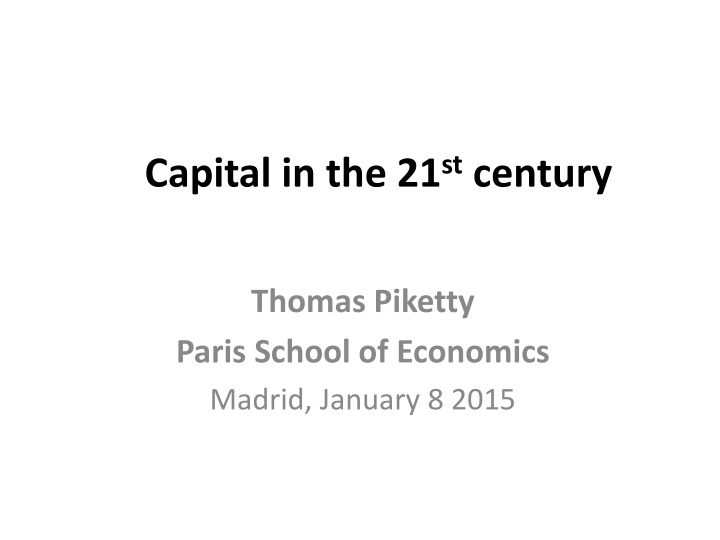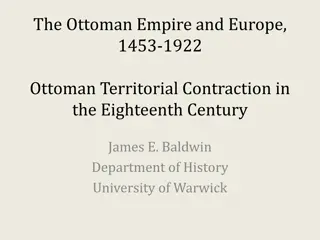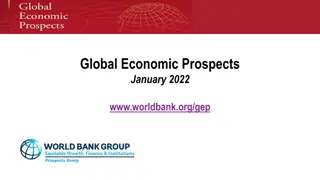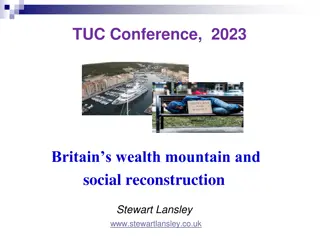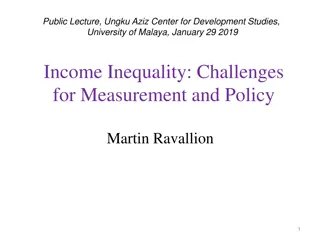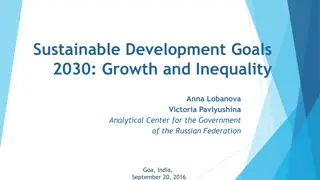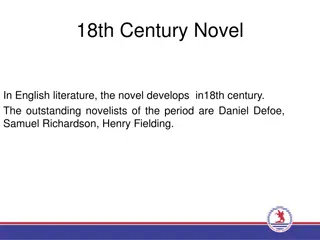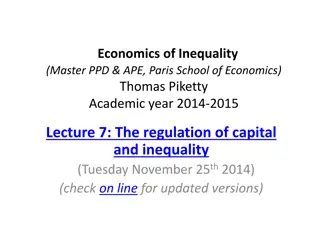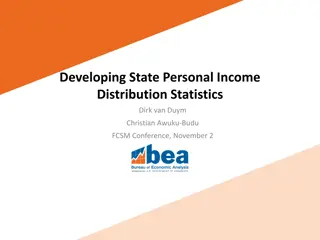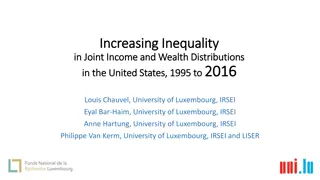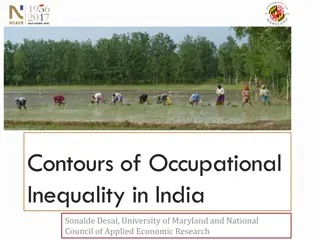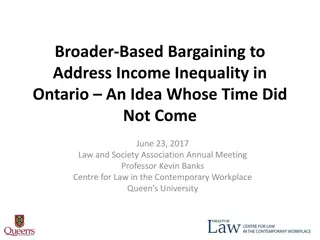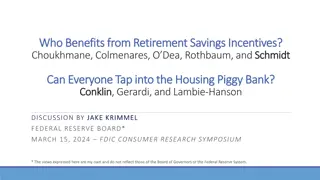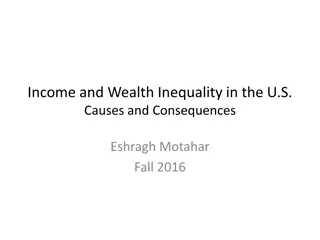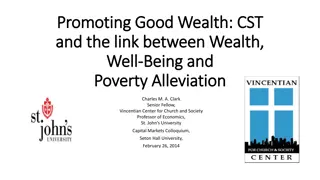Global Analysis of Income and Wealth Inequality Trends Since the 18th Century
Presentation based on "Capital in the 21st Century" by Thomas Piketty, exploring income and wealth distribution dynamics from the 18th century across 20+ countries. The focus is on shifting from rising income inequality to rising wealth inequality, analyzing the long-term evolution of capital/income ratios and wealth concentration. Historical data collected over 15 years with collaborators, including insights on regulations in the 21st century.
Download Presentation

Please find below an Image/Link to download the presentation.
The content on the website is provided AS IS for your information and personal use only. It may not be sold, licensed, or shared on other websites without obtaining consent from the author.If you encounter any issues during the download, it is possible that the publisher has removed the file from their server.
You are allowed to download the files provided on this website for personal or commercial use, subject to the condition that they are used lawfully. All files are the property of their respective owners.
The content on the website is provided AS IS for your information and personal use only. It may not be sold, licensed, or shared on other websites without obtaining consent from the author.
E N D
Presentation Transcript
Capital in the 21stcentury Thomas Piketty Paris School of Economics Madrid, January 8 2015
This presentation is based upon Capital in the 21stcentury (Harvard University Press, March 2014) This book studies the global dynamics of income and wealth distribution since 18c in 20+ countries; I use historical data collected over the past 15 years with Atkinson, Saez, Postel-Vinay, Rosenthal, Alvaredo, Zucman, and 30+ others; I try to shift attention from rising income inequality to rising wealth inequality The book includes four parts: Part 1. Income and capital Part 2. The dynamics of the capital/income ratio Part 3. The structure of inequalities Part 4. Regulating capital in the 21stcentury In this presentation I will present some results from Parts 2 & 3, focusing upon the long-run evolution of capital/income ratios and wealth concentration (all graphs and series are available on line: see http://piketty.pse.ens.fr/capital21c )
Figure I.1. Income inequality in the United States, 1910-2012 50% Share of top decile in total income (including capital gains) Share of top decile in national income Excluding capital gains 45% 40% 35% 30% 25% 1910 1920 The top decile share in U.S. national income dropped from 45-50% in the 1910s-1920s to less than 35% in the 1950s (this is the fall documented by Kuznets); it then rose from less than 35% in the 1970s to 45-50% in the 2000s-2010s. Sources and series: see 1930 1940 1950 1960 1970 1980 1990 2000 2010
Figure S5.2. Private capital in rich countries: from the Japanese to the Spanish bubble 800% U.S.A Japan Germany France 700% Value of private capital (% of national income) U.K. Italy Canada Australia 600% Spain 500% 400% 300% 200% 100% 1970 1975 1980 1985 1990 1995 2000 2005 2010 Private capital almost reached 8 years of national income in Spain at the end of the 2000s (ie. one more year than Japan in 1990). Sources and series: see piketty.pse.ens.fr/capital21c.
Supplementary slides (long lecture version)
This presentation: three points 1. The return of a patrimonial (or wealth-based) society in the Old World (Europe, Japan). Wealth-income ratios seem to be returning to very high levels in low growth countries. Intuition: in a slow-growth society, wealth accumulated in the past can naturally become very important. In the very long run, this can be relevant for the entire world. 2. The future of wealth concentration: with high r - g during 21c (r = net-of-tax rate of return, g = growth rate), then wealth inequality might reach or surpass 19coligarchic levels; conversely, suitable institutions can allow to democratize wealth. 3. Inequality in America ( meritocratic extremism ): is the New World developing a new inequality model that is based upon extreme labor income inequality more than upon wealth inequality? Is it more merit-based, or can it become the worst of all worlds?
1. The return of a wealth-based society Wealth = capital K = everything we own and that can be sold on a market (net of all debts) (excludes human K, except in slave societies) In textbooks, wealth-income & capital-ouput ratios are supposed to be constant. But the so-called Kaldor facts actually rely on little historical evidence. In fact, we observe in Europe & Japan a large recovery of =K/Y in recent decades: =200-300% in 1950-60s =500-600% in 2000-10s (i.e. average wealth K was about 2-3 years of average income Y around 1950-1960; it is about 5-6 years in 2000-2010) (with 600%, if Y 30 000 per capita, then K 180 000 per capita) (currently, K half real estate, half financial assets) Are we heading back to the =600-700% observed in the wealth-based societies of 18c-19c ? Or even more?
The simplest way to think about this is the following: in the long-run, =s/g with s = (net-of-depreciation) saving rate and g = economy s growth rate (population + productivity) With s=10%, g=3%, 300%; but if s=10%, g=1,5%, 600% = in slow-growth societies, the total stock of wealth accumulated in the past can naturally be very important capital is back because low growth is back (in particular because population growth 0) in the long run, this can be relevant for the entire planet Note: =s/g = pure stock-flow accounting identity; it is true whatever the combination of saving motives
Will the rise of capital income-ratio also lead to a rise of the capital share in national income? If the capital stock equals =6 years of income and the average return to capital is equal r=5% per year, then the share of capital income (rent, dividends, interest, profits, etc.) in national income equals = r x = 30% Technically, whether a rise in also leads to a rise in capital share = r depends on the elasticity of substitution between capital K and labor L in the production function Y=F(K,L) Intuition: measures the extent to which workers can be replaced by machines (e.g. Amazon s drones) Standard assumption: Cobb-Douglas production function ( =1) = as the stock , the return r exactly in the same proportions, so that = r x remains unchanged, like by magic = a stable world where the capital-labor split is entirely set by technology But if >1, then the return to capital r falls less than the volume of capital , so that the product = r x Exactly what happened since the 1970s-80s: both the ratio and the capital share have increased
With a large rise in , one can get large rise in with a production function F(K,L) that is just a little bit more substituable than in the standard Cobb-Douglas model (say if =1,5 instead of 1) Maybe it is natural to expect over the course of history: more and more diversified uses for capital; extreme case: pure robot-economy ( =infinity) Less extreme case: there are many possible uses for capital (machines can replace cashiers, drones can replace Amazon s delivery workers, etc.), so that the capital share continuously; there s no natural corrective mechanism for this The rise of and can be a good thing (we could all devote more time to culture, education, health , rather than to our own subsistance), assuming one can answer the following question: who owns the robots?
2. The future of wealth concentration In all European countries (UK, France, Sweden ), wealth concentration was extremely high in 18c-19c& until WW1: about 90% of aggregate wealth for top 10% wealth holders about 60% of aggregate wealth for top 1% wealth-holders = the classic patrimonial (wealth-based) society: a minority lives off its wealth, while the rest of the populaton works (Austen, Balzac) Today wealth concentration is still very high, but less extreme: about 60-70% for top 10%; about 20-30% for top 1% the bottom 50% still owns almost nothing (<5%) but the middle 40% now owns 20-30% of aggregate wealth = the rise of a patrimonial middle class How did it happen, and will it last? Will the patrimonial middle class expend, or will it shrink?
Key finding: there was no decline in wealth concentration prior to World War shocks; was it just due to shocks? Q.: Apart from shocks, what forces determine the long-run level of wealth concentration? A.: In any dynamic, multiplicative wealth accumulation model with random individual shocks (tastes, demographic,returns, wages,..), the steady-state level of wealth concentration is an increasing function of r - g (with r = net-of-tax rate of return and g = growth rate) With growth slowdown and rising tax competition to attract capital, r - g might well rise in the 21c back to 19clevels Future values of r also depend on technology ( >1?) Under plausible assumptions, wealth concentration might reach or surpass 19crecord levels: see global wealth rankings
3. Inequality in America ( meritocratic extremism ) Inequality in America = a different structure as in Europe: more egalitarian in some ways, more inegalitarian in some other dimensions The New World in the 19thcentury: the land of opportunity (capital accumulated in the past mattered much less than in Europe; perpetual demographic growth as a way to reduce the level of inherited wealth and wealth concentration) and also the land of slavery Northern US were in many ways more egalitarian than Old Europe; but Southern US were more inegalitarian We still have the same ambiguous relationship of America with inequality today: in some ways more merit-based; in other ways more violent (prisons)
The US distribution of income has become more unequal than in Europe over the course of the 20th century; it is now as unequal as pre-WW1 Europe But the structure of inequality is different: US 2013 has less wealth inequality than Europe 1913, but higher inequality of labor income
